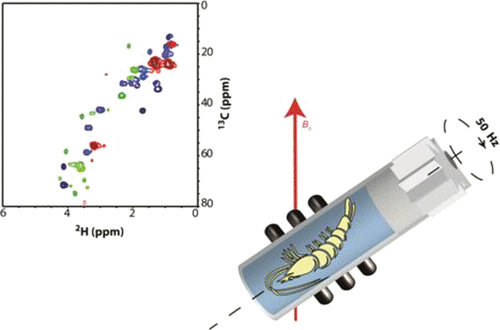Our official English website, www.x-mol.net, welcomes your
feedback! (Note: you will need to create a separate account there.)
In Vivo Ultraslow MAS 2H/13C NMR Emphasizes Metabolites in Dynamic Flux
ACS Omega ( IF 3.7 ) Pub Date : 2018-12-11 00:00:00 , DOI: 10.1021/acsomega.8b02882 Yalda Liaghati Mobarhan , Ronald Soong , Wolfgang Bermel 1 , Myrna J. Simpson , Jochem Struppe 2 , Hermann Heumann 3 , Sebastian Schmidt 3 , Holger Boenisch 3 , Daniel Lane , Andre J. Simpson
ACS Omega ( IF 3.7 ) Pub Date : 2018-12-11 00:00:00 , DOI: 10.1021/acsomega.8b02882 Yalda Liaghati Mobarhan , Ronald Soong , Wolfgang Bermel 1 , Myrna J. Simpson , Jochem Struppe 2 , Hermann Heumann 3 , Sebastian Schmidt 3 , Holger Boenisch 3 , Daniel Lane , Andre J. Simpson
Affiliation

|
NMR spectroscopy is a powerful tool for metabolite screening, and owing to its noninvasive nature, it can be applied in vivo. However, the magnetic susceptibility mismatches within the intact organisms, lead to broad signals and loss of spectral information. Magic-angle spinning (MAS) is the most robust way to reduce these distortions, enhancing line shapes and providing a wealth of metabolic information, in vivo. Unfortunately, mainly due to overlapping water sidebands, relatively fast spinning is required (∼2500 Hz), which induces stress on the organism, leading to mortality within a relatively short time frame. Here, a novel approach is introduced utilizing 2H/13C isotopic enrichment that demonstrates the following advantages. (1) 2H is a quadrupolar nucleus; hence, in 2H/13C two-dimensional (2D) NMR only the most dynamic molecules (mobile metabolites) are observed in vivo, whereas structural components are broadened beyond detection. In turn, this results in a well-resolved and unique window into the dynamic metabolite pool that includes newly released or synthesized molecules correlated to a biological response/process. (2) 2H shares the same chemical shift window as 1H, making assignment relatively easy. (3) 2H detection reduces problems associated with the water peak, and as the dynamic molecules are selectively detected, no sidebands are observed. (4) As such, samples can be spun slowly (50 Hz), reducing the stress and increasing 100% survivability to 24 h for Daphnia magna and 48 h for Hyalella azteca. To our knowledge, this represents the only MAS-based NMR approach that can provide high-resolution 2D NMR in vivo metabolic fingerprint at slow spinning rates.
中文翻译:

体内超低MAS 2 H / 13 C NMR强调动态通量中的代谢产物
NMR光谱是代谢物筛选的有力工具,由于其无创性,因此可以在体内应用。但是,完整生物体内的磁化率不匹配,会导致信号泛滥和光谱信息丢失。魔角旋转(MAS)是在体内减少这些变形,增强线形并提供丰富的代谢信息的最强大的方法。不幸的是,主要是由于重叠的水边带,需要相对较快的旋转(〜2500 Hz),这会在生物体上产生压力,从而在相对较短的时间内导致死亡。在这里,介绍了一种利用2 H / 13 C同位素富集的新颖方法,该方法证明了以下优点。(1)2H是四极核;因此,在2 H / 13 C二维(2D)NMR中,在体内仅观察到最有活力的分子(移动代谢物),而结构成分却超出了检测范围。反过来,这导致进入动态代谢物库的解析度高且唯一的窗口包括新释放或合成的与生物学响应/过程相关的分子。(2)2 H股相同的化学位移窗口1 H,使得分配相对容易。(3)2H检测减少了与水峰相关的问题,并且由于选择性检测了动态分子,因此未观察到边带。(4)因此,样品可以缓慢旋转(50 Hz),从而减轻了压力,使大型蚤(Daphnia magna)的存活时间提高到24小时,而阿兹特利亚透明质酸(Hyellaella azteca)的存活率提高了100%。据我们所知,这代表了唯一基于MAS的NMR方法,可以在慢速旋转速率下提供高分辨率的2D NMR体内代谢指纹。
更新日期:2018-12-11
中文翻译:

体内超低MAS 2 H / 13 C NMR强调动态通量中的代谢产物
NMR光谱是代谢物筛选的有力工具,由于其无创性,因此可以在体内应用。但是,完整生物体内的磁化率不匹配,会导致信号泛滥和光谱信息丢失。魔角旋转(MAS)是在体内减少这些变形,增强线形并提供丰富的代谢信息的最强大的方法。不幸的是,主要是由于重叠的水边带,需要相对较快的旋转(〜2500 Hz),这会在生物体上产生压力,从而在相对较短的时间内导致死亡。在这里,介绍了一种利用2 H / 13 C同位素富集的新颖方法,该方法证明了以下优点。(1)2H是四极核;因此,在2 H / 13 C二维(2D)NMR中,在体内仅观察到最有活力的分子(移动代谢物),而结构成分却超出了检测范围。反过来,这导致进入动态代谢物库的解析度高且唯一的窗口包括新释放或合成的与生物学响应/过程相关的分子。(2)2 H股相同的化学位移窗口1 H,使得分配相对容易。(3)2H检测减少了与水峰相关的问题,并且由于选择性检测了动态分子,因此未观察到边带。(4)因此,样品可以缓慢旋转(50 Hz),从而减轻了压力,使大型蚤(Daphnia magna)的存活时间提高到24小时,而阿兹特利亚透明质酸(Hyellaella azteca)的存活率提高了100%。据我们所知,这代表了唯一基于MAS的NMR方法,可以在慢速旋转速率下提供高分辨率的2D NMR体内代谢指纹。











































 京公网安备 11010802027423号
京公网安备 11010802027423号